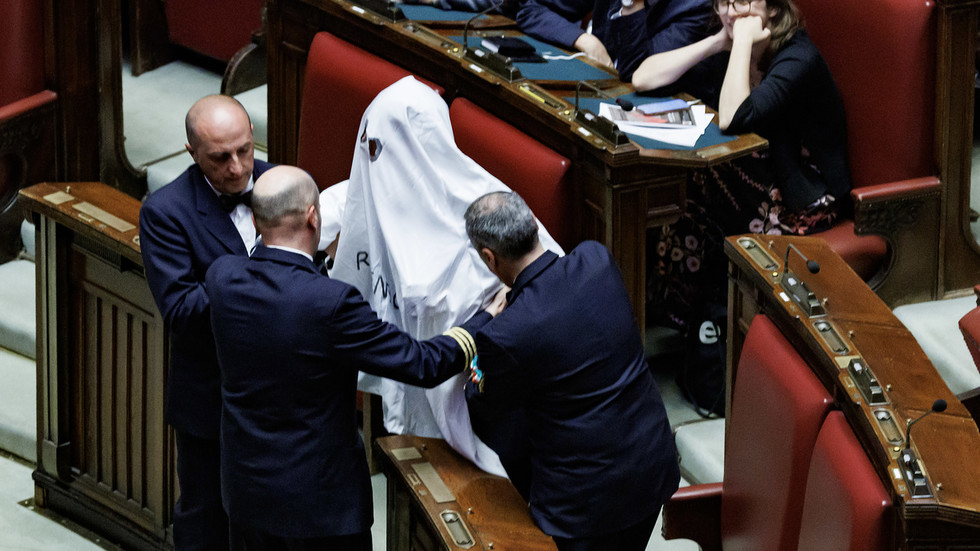Last week, Russian President Vladimir Putin escalated his war against Ukraine by illegally annexing four Ukrainian regions — and, in a belligerent speech, raised the specter of using nuclear weapons, ominously noting that the United States had set a precedent when it dropped atomic bombs on Hiroshima and Nagasaki in 1945.
This threat followed one he had made just days earlier when he called for a partial military mobilization: “In the event of a threat to the territorial integrity of our country and to defend Russia and our people, we will certainly make use of all weapon systems available to us. This is not a bluff.”
Whether Putin is bluffing has quickly become the most important question in international security.
This is not the first time Putin has threatened the use of nuclear weapons. He did so on the day Russia invaded Ukraine, when he warned that any NATO involvement would lead to “consequences as you have never experienced in your history.”
But there are good reasons to take the threat more seriously now.
Russian military doctrine allows for the use of nuclear weapons in the event that “the very existence of the state is in jeopardy.” By declaring the regions of Donetsk, Luhansk, Zaporizhzhia, and Kherson to be part of Russia, Putin has sought to frame any recovery by Ukraine of its own territory as a threat to Russia’s “territorial integrity.” It’s a nonsensical claim given that he started the war by violating Ukraine’s territorial integrity, but one that does give his threat some weight.
Consequently, many security experts believe the risk of nuclear war has increased. Rose Gottemoeller, a former deputy secretary-general of NATO, told the BBC she worries “they will strike back now in really unpredictable ways that may even involve weapons of mass destruction.”
The White House has said it would respond forcefully to any Russian use of nuclear weapons. Jake Sullivan, President Joe Biden’s national security adviser, said that Russia would suffer “catastrophic consequences” if it crossed that line. Secretary of State Antony Blinken echoed that warning, saying, “It’s very important that Moscow hear from us and know from us that the consequences would be horrific. And we’ve made that very clear.”
Yet all these attempts at clarity have begat confusion. The United States has not publicly stated what these “catastrophic consequences” would be (though Sullivan said that the White House had privately “spelled out” the implications for the Russians). Nor has Putin specified exactly when or how he would employ nuclear weapons.
The vagueness on both sides leaves us with the unsettling question of what exactly we’re talking about when we talk about nuclear war — and what the risks truly are. We cannot know whether Putin will “go nuclear”; Putin may not know, himself. But breaking down clearly what his threat might entail, why he might go through with it, and what we know — and don’t know — about nuclear escalation can offer us a framework within which to think about the unthinkable.
What Russia means when it threatens the use of nuclear weapons
The chief concern among security experts is that Putin might use a “tactical” or “non-strategic” nuclear weapon against Ukraine. The term has no precisely agreed-upon definition, but the commonly accepted differences between “tactical” and “strategic” weapons concern their power, range, and purpose.
Tactical weapons tend to have lower explosive yields, to be delivered by planes and missiles with shorter ranges, and to accomplish aims on the battlefield. A 2016 Department of Defense document focused on this latter point: “Non-strategic or tactical nuclear weapons refer to nuclear weapons designed to be used on a battlefield in military situations. This is opposed to strategic nuclear weapons, which are designed to be used against enemy cities, factories, and other larger-area targets to damage the enemy’s ability to wage war.”
Put more simply, one would use a tactical nuclear weapon to help win a battle, but a strategic one to win a war.
But these terms can obscure more than they clarify because tactical nuclear weapons can be used for strategic ends. The atomic bombs that the United States dropped on Hiroshima and Nagasaki would be classified as tactical today by dint of their “modest” explosive power — but they were used for a strategic purpose: to force Japan’s surrender. (The bomb that destroyed Hiroshima had a yield of approximately 15 kilotons — that is, equal to 12,000 tons of TNT — whereas the explosive power of the warheads that US ICBMs carry today is approximately 20 times greater.)
What’s more, any use of a nuclear weapon would have strategic repercussions because it would violate the longstanding nuclear taboo, even though the extent of destruction would vary widely depending on the target and the conditions under which it was used. In terms of collateral damage — civilians killed, property destroyed, land contaminated — a Russian ICBM launched at a remote missile silo in North Dakota would have a significantly different effect than a tactical weapon used on a European battlefield that abuts a large city.
So why have the terms at all? During the Cold War, it was helpful to distinguish between the weapons that NATO and the Warsaw Pact countries might use in combat from the forces that the US and Soviet Union might use to annihilate one another. This distinction also provided a useful starting point for arms control.
In their early attempts to limit the arms race, US and Soviet negotiators had to begin somewhere, so they focused on weapons that could strike each other’s homelands. They dubbed these “strategic” weapons. Today, these weapons remain limited by New START, a 2010 agreement that allows each side to deploy no more than 1,550 strategic warheads distributed among 700 launch vehicles; that is, heavy bombers, submarine-launched ballistic missiles, and intercontinental ballistic missiles.
But the threat of mutual annihilation remains intact. To the extent that deterrence between the United States and Russia has prevented nuclear war, that dynamic persists.
Why Putin might resort to tactical nuclear weapons
That leaves the problem of “tactical” nuclear weapons. The reason the distinction can cause some confusion is that, with respect to Ukraine, the focus on “tactical” distracts us from the various ways in which Putin might use a nuclear weapon. Let’s consider three.
First, Putin might use tactical nuclear weapons to achieve a limited military objective. Although there is a lot of talk about Putin’s “irrationality” (and it is hard not to see him as unhinged after his Friday speech), there is nothing inherently irrational about using tactical nuclear weapons to offset a conventional disadvantage — which is what makes it a frightening possibility. During the Cold War, for example, the United States prepared to use tactical nuclear weapons to defend Western Europe in the event that the much larger Red Army invaded.
With his conventional forces facing setbacks, Putin might use a small number of tactical nuclear weapons in Ukraine to achieve a battlefield objective. The question is, what battlefield objective? Even small nuclear weapons are best for blowing up big things — carrier strike groups, tank columns, massed infantry, etc. — and the war in Ukraine has been one of attrition. There are certainly targets that Russia could strike, but incurring the cost of breaking the nuclear taboo for nondecisive military gain makes little sense.
Besides, if he were trying to repel Ukraine from “retaking” the four newly annexed territories, he would have to use nuclear weapons on “Russian” soil. Generally speaking, one does not want to use nuclear weapons on one’s own territory, especially when fallout from the explosion could drift over Russia proper.
Another scenario: Putin could target Kyiv and other Ukrainian cities to force Ukraine to capitulate — in other words, to accomplish a strategic aim. But that threat so far seems to have had little effect on the Ukrainians.
The question is whether their defiance would hold in the face of an actual nuclear attack. The Ukrainian people have shown remarkable fortitude throughout the war. But the horrific and gruesome destruction of one or more cities, with the threat of more punishment to come, would force a terrible choice on Ukrainian leaders.
A third scenario would involve Putin using a tactical nuclear weapon in the hope of dissuading NATO from providing Ukraine further military assistance or from actually joining the combat.
Thus far, the primary “use” of Russia’s nuclear arsenal has been to deter NATO from entering the war directly. In this, Putin has succeeded, in a sense.
It’s self-evident that if two nuclear superpowers go to war, the odds of the apocalypse increase dramatically, and the United States recognizes the danger of escalation. Biden and his advisers have repeatedly said that they have no interest in triggering World War III. That’s why, from the beginning of the war, the president made it clear that he would not send American troops to Ukraine. The administration’s refusal to impose a no-fly zone was driven by the same logic. Although some analysts disparaged these moves as caving to Putin’s bullying, supporting Ukraine while eschewing direct NATO involvement is prudent.
The danger of escalation — and our ignorance
But even as prudence has won out so far, we are still closer to nuclear war than we have been in decades.
And that prompts a disquieting question: If Putin were to use nuclear weapons against Ukraine, how should the United States respond? We have gobs of theory about how nuclear weapons deter (or don’t), but we have few empirics to back up any of the assertions.
As the security scholar Francis Gavin has written, political scientists, who inhabit an increasingly quantitative discipline, have few “Ns” with which to work when it comes to this subject — that is, the sample size to base their analysis on is small. Nine states have nuclear weapons, two atomic bombs have been detonated in wartime, and zero thermonuclear wars have been waged.
That zero presents a real analytical problem, though it’s a problem we’d like to continue having. The job of nuclear strategist — a role that has been played by some of the smartest (one might say rational) defense experts of the last 75 years — is a largely faith-based endeavor. As Alain Enthoven, one of former Defense Secretary Robert McNamara’s youthful Pentagon “whiz kids,” reportedly said to a general in the middle of a heated argument: “General, I have fought just as many nuclear wars as you have.”
Experts disagree wildly about fundamental questions concerning nuclear weapons.
- Is nuclear proliferation dangerous (because the probability of use, intentional or accidental, increases with every nuclear weapon deployed), or is it actually stabilizing (because the consequences are so horrific that the threat deters aggression)?
- Relatedly, did we experience an unprecedented period of great-power peace during the Cold War because nuclear weapons made the costs of conflict too high — or did we simply get lucky?
- Is deterrence stable — that is, requiring only the threat of minimal retaliation — or is the “balance of terror” delicate, requiring constant attention to the maintenance of nuclear parity, if not superiority?
- Are world leaders deterred by the smallest chance of triggering a strategic nuclear exchange, or do they see a viable path to nuclear victory by dominating the so-called escalatory ladder that runs from conventional skirmishes all the way up to, in Herman Kahn’s grotesque term, “wargasm”?
This last question raises the unresolved debate most germane today: Is it possible to control escalation once a nuclear weapon has been used? We have no data, only scenarios and metaphors. Should we be thinking about ladders or escalators or vortexes or slippery slopes? The truth is: We don’t know.
One could enlarge the data set. We have experienced nuclear crises before, the most serious and well-understood being the Cuban missile crisis. But 60 years later, historians are still piecing together what happened in October 1962, and it remains unclear whether we have learned the right lessons, or any lessons at all. From a social science perspective, single case studies can generate theory, but theory does not become knowledge until it is tested — which is precisely the thing we are trying to avoid in the case of nuclear weapons.
Social science might also tell us what different types of people are likely to do — but it cannot predict the actions of a particular individual in an unknown circumstance. In the current instance, the escalatory dynamics are contingent on the personalities and idiosyncrasies of two men: Putin and Biden.
Although defense experts often use game theory to explain nuclear dynamics, crisis management can come down to a matter of personalities operating under tremendous pressure. And it is not unreasonable to think that even carefully calibrated policies would go out the window under the shadow of a mushroom cloud.
Where does this leave the United States and the West?
In a difficult bind. There is an unmistakable tension in the two overriding goals of US strategy: inflict maximum pain on Russia, while minimizing the potential for nuclear escalation. In the event Putin pursues the unthinkable, the United States and other nations must punish Russia for violating the nuclear taboo — but they must do so in a way that doesn’t prompt Putin to violate it further.
Balancing those competing imperatives — punishing without provoking — requires tremendous intellectual agility. Policymakers must hold multiple ideas in their heads at the same time. They must threaten clearly, so as to clarify Putin’s judgment — while maintaining ambiguity that leaves room to maneuver in the face of different circumstances. (After all, a so-called “demonstration shot,” whereby Putin detonates a nuclear weapon over, say, the Black Sea to signal resolve, would be rather different from mass-murdering the residents of Kyiv.)
In the event of any nuclear use, the US and its allies must impose severe losses on Putin that somehow do not make him feel that he has nothing left to lose. If the US backs him into a corner psychologically, he may fail to see that he can back away physically. The West must stoke the moral sympathy for Ukraine that pushes the international community to do the right thing — but also muster the cognitive empathy for Russia that allows the US and NATO to do the smart thing. They must rally a global front against Putin without succumbing to the us-versus-them Manichaeism that makes compromise and coexistence impossible.
Ultimately, Russian aggression must stop, but resolving this conflict begins with a clear understanding of what we don’t understand — and a recognition of the paradoxes and uncertainties we face.
J. Peter Scoblic is a senior fellow in the International Security Program at the New America think tank, a fellow at Harvard’s Kennedy School, and the author of U.S. vs. Them, a history of American nuclear strategy.
















